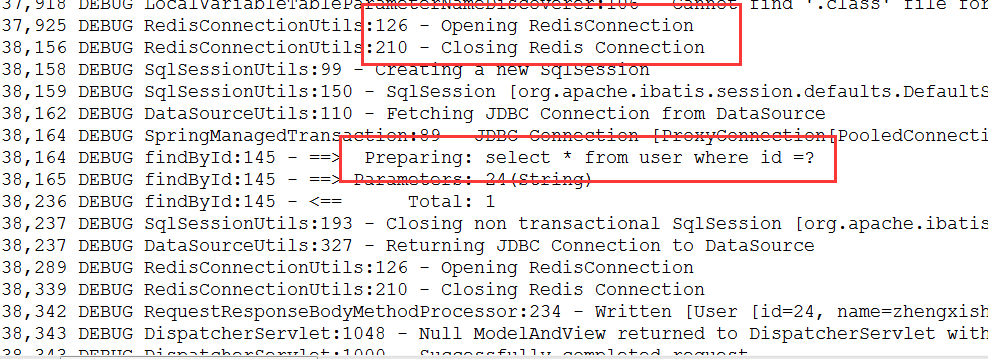pom.xml引入jar包,如下:
<dependency> <groupId>org.springframework.boot</groupId> <artifactId>spring-boot-starter-data-redis</artifactId> </dependency>
修改项目启动类,增加注解@EnableCaching,开启缓存功能,如下:
import org.springframework.boot.SpringApplication; import org.springframework.boot.autoconfigure.SpringBootApplication; import org.springframework.cache.annotation.EnableCaching; import org.springframework.scheduling.annotation.EnableScheduling; @SpringBootApplication @EnableScheduling @EnableCaching public class SpringbootApplication{ public static void main(String[] args) { SpringApplication.run(SpringbootApplication.class, args); } }
application.properties中配置Redis连接信息,如下:
# Redis数据库索引(默认为0)
spring.redis.database=0
# Redis服务器地址
spring.redis.host=172.31.19.222
# Redis服务器连接端口
spring.redis.port=6379
# Redis服务器连接密码(默认为空)
spring.redis.password=
# 连接池最大连接数(使用负值表示没有限制)
spring.redis.pool.max-active=8
# 连接池最大阻塞等待时间(使用负值表示没有限制)
spring.redis.pool.max-wait=-1
# 连接池中的最大空闲连接
spring.redis.pool.max-idle=8
# 连接池中的最小空闲连接
spring.redis.pool.min-idle=0
# 连接超时时间(毫秒)
spring.redis.timeout=0
新建Redis缓存配置类RedisConfig,如下:
import org.springframework.beans.factory.annotation.Value; import org.springframework.cache.CacheManager; import org.springframework.cache.annotation.CachingConfigurerSupport; import org.springframework.cache.annotation.EnableCaching; import org.springframework.context.annotation.Bean; import org.springframework.context.annotation.Configuration; import org.springframework.data.redis.cache.RedisCacheManager; import org.springframework.data.redis.connection.RedisConnectionFactory; import org.springframework.data.redis.core.RedisTemplate; import org.springframework.data.redis.core.StringRedisTemplate; import org.springframework.data.redis.serializer.Jackson2JsonRedisSerializer; import com.fasterxml.jackson.annotation.JsonAutoDetect; import com.fasterxml.jackson.annotation.PropertyAccessor; import com.fasterxml.jackson.databind.ObjectMapper; /** * Redis缓存配置类 * @author szekinwin * */ @Configuration @EnableCaching public class RedisConfig extends CachingConfigurerSupport{ @Value("${spring.redis.host}") private String host; @Value("${spring.redis.port}") private int port; @Value("${spring.redis.timeout}") private int timeout; //自定义缓存key生成策略 // @Bean // public KeyGenerator keyGenerator() { // return new KeyGenerator(){ // @Override // public Object generate(Object target, java.lang.reflect.Method method, Object... params) { // StringBuffer sb = new StringBuffer(); // sb.append(target.getClass().getName()); // sb.append(method.getName()); // for(Object obj:params){ // sb.append(obj.toString()); // } // return sb.toString(); // } // }; // } //缓存管理器 @Bean public CacheManager cacheManager(@SuppressWarnings("rawtypes") RedisTemplate redisTemplate) { RedisCacheManager cacheManager = new RedisCacheManager(redisTemplate); //设置缓存过期时间 cacheManager.setDefaultExpiration(10000); return cacheManager; } @Bean public RedisTemplate<String, String> redisTemplate(RedisConnectionFactory factory){ StringRedisTemplate template = new StringRedisTemplate(factory); setSerializer(template);//设置序列化工具 template.afterPropertiesSet(); return template; } private void setSerializer(StringRedisTemplate template){ @SuppressWarnings({ "rawtypes", "unchecked" }) Jackson2JsonRedisSerializer jackson2JsonRedisSerializer = new Jackson2JsonRedisSerializer(Object.class); ObjectMapper om = new ObjectMapper(); om.setVisibility(PropertyAccessor.ALL, JsonAutoDetect.Visibility.ANY); om.enableDefaultTyping(ObjectMapper.DefaultTyping.NON_FINAL); jackson2JsonRedisSerializer.setObjectMapper(om); template.setValueSerializer(jackson2JsonRedisSerializer); } }
新建UserMapper,如下:
import org.apache.ibatis.annotations.Delete; import org.apache.ibatis.annotations.Insert; import org.apache.ibatis.annotations.Mapper; import org.apache.ibatis.annotations.Param; import org.apache.ibatis.annotations.Select; import org.apache.ibatis.annotations.Update; import org.springframework.cache.annotation.CacheConfig; import org.springframework.cache.annotation.CacheEvict; import org.springframework.cache.annotation.CachePut; import org.springframework.cache.annotation.Cacheable; import springboot.domain.User; @Mapper @CacheConfig(cacheNames = "users") public interface UserMapper { @Insert("insert into user(name,age) values(#{name},#{age})") int addUser(@Param("name")String name,@Param("age")String age); @Select("select * from user where id =#{id}") @Cacheable(key ="#p0") User findById(@Param("id") String id); @CachePut(key = "#p0") @Update("update user set name=#{name} where id=#{id}") void updataById(@Param("id")String id,@Param("name")String name); //如果指定为 true,则方法调用后将立即清空所有缓存 @CacheEvict(key ="#p0",allEntries=true) @Delete("delete from user where id=#{id}") void deleteById(@Param("id")String id); }
@Cacheable将查询结果缓存到redis中,(key="#p0")指定传入的第一个参数作为redis的key。
@CachePut,指定key,将更新的结果同步到redis中
@CacheEvict,指定key,删除缓存数据,allEntries=true,方法调用后将立即清除缓存
(6)service层与controller层跟上一篇整合一样,启动redis服务器,redis服务器的安装与启动可以参考之前的博客,地址如下:
http://www.cnblogs.com/gdpuzxs/p/6623171.html
(7)配置log4j日志信息,如下:
## LOG4J配置 log4j.rootCategory=DEBUG,stdout ## 控制台输出 log4j.appender.stdout=org.apache.log4j.ConsoleAppender log4j.appender.stdout.layout=org.apache.log4j.PatternLayout log4j.appender.stdout.layout.ConversionPattern=%d{yyyy-MM-dd HH:mm:ss,SSS} %5p %c{1}:%L - %m%n
验证redis缓存
首先我们向user表总插入一条数据,数据库显示如下:

现在,我们查询一下user表中id=24的数据,观擦控制台输出的信息,如下:

通过控制台输出信息我们可以知道,这次执行了数据库查询,并开启了Redis缓存查询结果。接下来我们再次查询user表中id=24的数据,观察控制台,如下:

通过控制台输出信息我们可以知道,这次并没有执行数据库查询,而是从Redis缓存中查询,并返回查询结果。我们查看redis中的信息,如下:

方法finduser方法使用了注解@Cacheable(key="#p0"),即将id作为redis中的key值。当我们更新数据的时候,应该使用@CachePut(key="#p0")进行缓存数据的更新,否则将查询到脏数据。